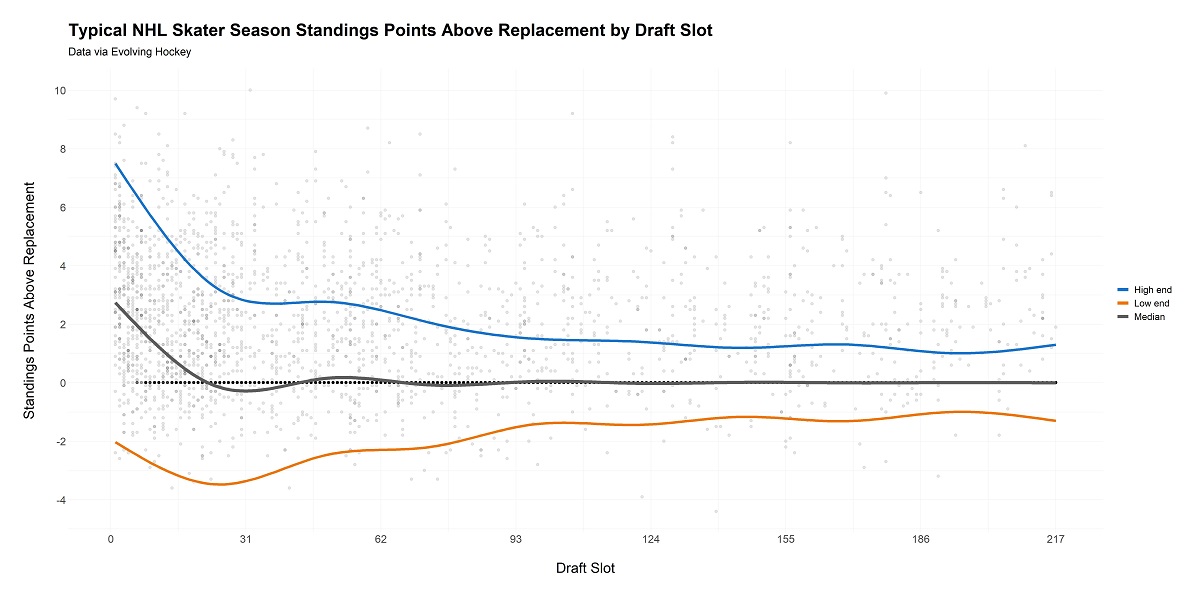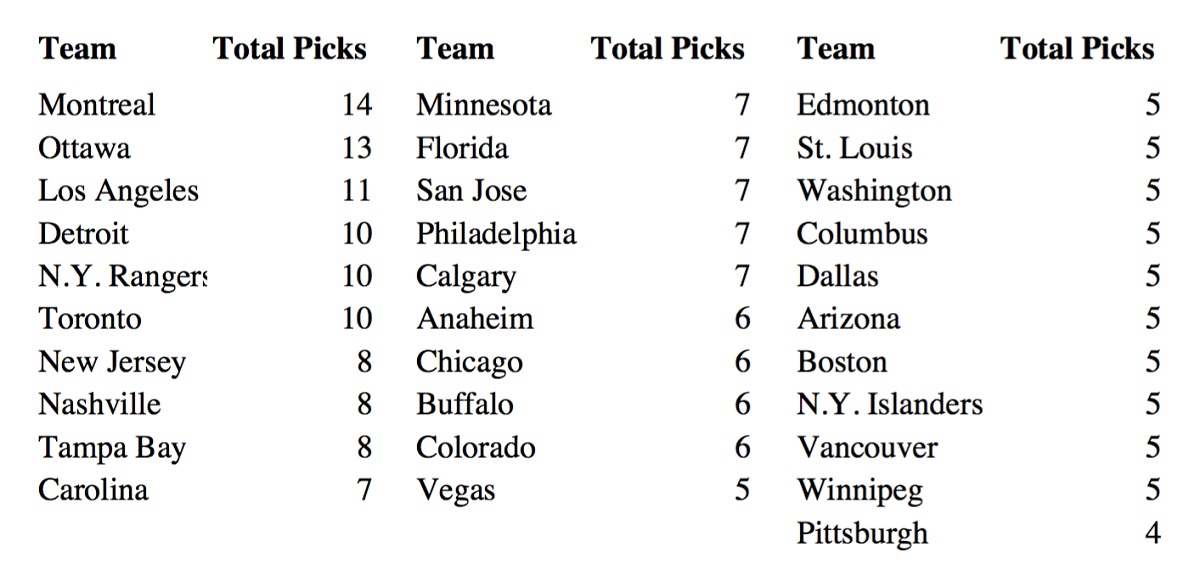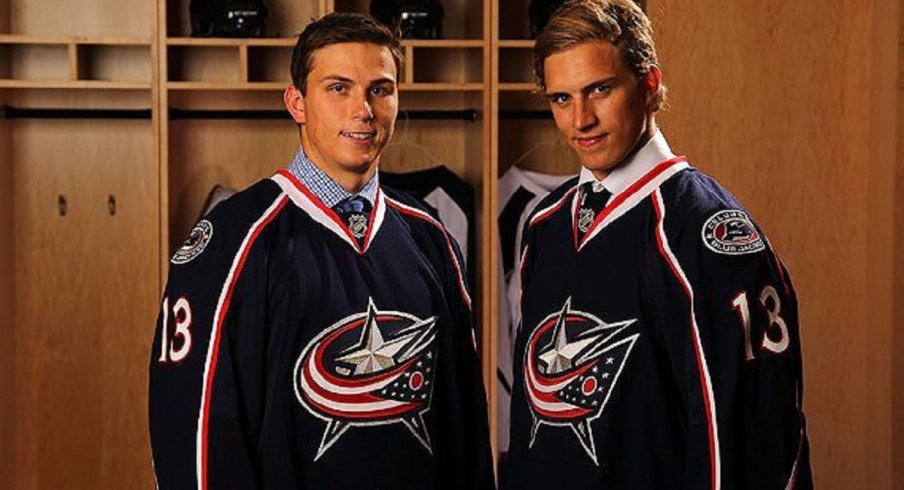I've always considered myself something of a "draft nerd".
The concept of building towards a brighter future, finding diamonds in the rough, evaluating/projecting players, and watching unknown (too many) players develop (my favorite anecdote was trying to convince my friends in college that little Cam Atkinson, picked 157th overall, could really become a player in time) has always been fascinating to me. I don't have to force myself to listen to prospect podcasts, make myself watch an obscure match-up at the World Junior Championships, or watch a random USHL game on HockeyTV. It's just become a part of my routine.
I'm not unique; the Columbus Blue Jackets organizational culture is in many ways dominated by the draft. Jarmo Kekalainen started out as a scout with the Ottawa Senators in 1995 before climbing the ladder to where he is today. Assistant GM Josh Flynn developed a value chart that helps the club more easily scientifically assess potential trades. Perhaps more than other organizations, who can lean more heavily on recruiting marquee unrestricted free agents, the Blue Jackets put a huge premium on the draft.
This is why many have found it peculiar/striking that the club has parted with its first-round pick with so much frequency in recent years. Since Pierre-Luc Dubois was taken third-overall in 2016, the club has drafted in the first round just once, selecting Liam Foudy with the 18th pick in 2018. That has to be torture for Kekalainen and co., trading away their crown jewel year-in and year-out, right?
Some Context
Maybe, but maybe not. There has been a plethora of excellent work in the public sphere surrounding the draft. In essence, everyone is trying to answer some variation of the same question: what is a draft pick worth?
The Tampa Bay Lightning's SB Nation website, Rawcharge, recently posted an excellent article that contextualized draft pick values. Thank goodness @loserpoints wrote this piece because it so eloquently synthesized what I've had stewing in my brain but have never been able to successfully articulate.
The TL;DR: first-round picks are valuable, but they're not all created equally (obviously). Picking in the bottom half of the first round is a lot more like picking in the second round than it is at the top of the first round. After a few rounds, it's a total crapshoot. From the article:
By the end of the first round, the difference in value between picks has decreased significantly. The median pick will be a replacement level player but the opportunity still exists to get a difference maker. By the third round, that opportunity is mostly gone and we see very little difference in pick value over the remainder of the draft. Pretty much everything from the third round on is a lottery ticket.
Using Evolving-Hockey's Standings Points Above Replacement (SPAR) metric as its data set, the article shows typical player contributions over time by draft slot. Note: SPAR is an advanced metric that, while utilized by many in the public hockey analytics space, isn't necessarily a complete catch-all of a player's comprehensive contributions. Regardless, the points remain that a) there is an enormous advantage to picking early in the first round and b) there is virtually no difference in a typical player's contribution once we get past the second round.

See that steep drop off? It happens early in the first round. The Athletic's Jonathan Willis with this brilliant factoid:
It’s easy to pick on the handful of high-profile disasters at the top end of the draft, but there’s a remarkable statistic that shows this truth: five.
Five here means fifth overall. That’s the median draft position of the 31 most-used forwards in the NHL in 2019-20. This elite group of forwards, all of whom play 20-odd minutes per game, were picked out early by the league’s bird dogs. Two-thirds were top-10 picks.
This has several implications:
- Contending teams tend to overrate the value of their (inherently later) first-round pick and should be more aggressive in trading it for an impact player that can help immediately.
- Expectations must be tempered for players picked in the middle/late stages of the first round.
- Having additional picks in the later (4th-7th) rounds, where it is typically easier to acquire picks, is an under-appreciated (or at least under-utilized) strategy.
Should Teams Be More Inclined To Move Their Mid/Late First-Round Draft Pick?
Kekalainen shouldn't (and wouldn't) do this every year, but I believe the Matt Duchene trade has passed the test of time. The Blue Jackets were a legitimate contender that challenged a team that ultimately lost in Game 7 of the Stanley Cup Finals, and Duchene was a key player during that run. Even if Lassi Thompson (the player the Ottawa Senators selected with Columbus' first-round pick) becomes a good player (and that's far from a given), the risk was worth it.
The Blue Jackets know all-too-well about mid/late first-round picks not meeting the lofty expectation of their draft position. Since Kekalainen took over the draft in 2013, here are the first-round picks taken by the Blue Jackets outside of the top 10:
| Year | Pick # | Name | GP | Points |
|---|---|---|---|---|
| 2013 | 14 | Alexander Wennberg | 415 | 201 |
| 2013 | 19 | Kerby Rychel | 43 | 14 |
| 2013 | 27 | Marko Dano | 141 | 45 |
| 2014 | 16 | Sonny Milano | 125 | 47 |
| 2015 | 29 | Gabriel Carlsson | 23 | 3 |
Omitting Foudy, who is too green for this exercise, how many of these players have "panned out"? One? None? It all depends on expectations. If your expectation is that a first-round pick is a first-round pick, damnit, and that first-round picks portend a prolific NHL career, you're likely to be disappointed. However, the results shouldn't come as a surprise.
Teams swing and miss on mid/late first-round picks all the time. Hell, the Blue Jackets had three mid/late first-round picks in 2014. That didn't go as planned. Two of those three players are out of the NHL. The other, Wennberg, was a frequent healthy scratch in last season's playoffs. In 2015, the Bruins had three-consecutive first-round picks (13-14-15) and turned it into one bonafide NHLer (Jake DeBrusk) and two guys who have combined to play eight games in the NHL (Jakub Zboril and Zach Senyshyn).
That is to say, historically, mid/late first-round players don't typically go on to have the illustrious careers we've come to expect. As @loserpoints suggests, the below players represent the "median prime performance" of a player one would expect to draft at their given draft slot.
| Year | Pick # | Name |
|---|---|---|
| 2011 | 14 | Jamie Oleksiak |
| 2004 | 19 | Kyle Chipchura |
| 2003 | 27 | Brian Boyle |
| 2009 | 16 | Nick Leddy |
| 2001 | 29 | David Steckel |
While it's not a perfect science, the point remains that none of the above players jump off the page. When teams draft, say, #14, they should expect to draft a player that will typically become something like a Jamie Oleksiak. He's a solid defenseman on the Dallas Stars who, at 27, is coming into his own. He probably had the best season of his career in 2019-20.
But if you were a contending team's GM, would you trade the upcoming 14th pick in the draft for an impact player that can help you win immediately? Or would you prefer to hold onto the pick? If the #14 pick is anything like Oleksiak (and he typically is), you may have to wait many (in this case eight) years for an impactful player, if at all. Most GM's believe that they can beat the stock market and find the perfect investment at #14. They don't make the trade. But I think they should.
Throwing Darts At A Dartboard
Regardless of if a GM trades their mid/late first-round pick, they should always be on the prowl to add plenty of picks late in the draft. Kekalainen has done a masterful job unearthing talent in the later rounds of the draft, particularly discovering defensemen Vladislav Gavrikov (159th overall) and Markus Nutivaara (189). Finding Oliver Bjorkstrand (89) and Elvis Merzlikins (76) was key, too. The jury is still out on other non-top-sixty picks, but the fact is there is a limited amount of gold to be mined after the top ~10 picks in any draft, and he's done well to mine it.
All teams start with the same number of "lottery tickets". Those in rebuilds make sure they end with more as they clean house. Contenders have fewer picks as they parlay picks into players for playoff runs. Per Sportsnet, here's a look at where each team stands (as of now) heading into the 2020 NHL Draft:

The Blue Jackets, in my opinion, were poised to move some of their forward depth for later-round pieces in the upcoming draft. That's now in jeopardy, as the entire order of operations is up in the air. Hopefully, they're able to recoup some of those darts.
Parting Thoughts
This isn't to say that first-round picks aren't valuable - of course we know they are. Per Willis' findings, 175 of the 372 most used forwards in the NHL in 2019-20 were picked in the top 31. As @loserpoints says succinctly, it's just that we "need to think of those values in terms of what they’re likely to mean on the ice. The 10th pick in the draft is valuable. But a team isn’t likely to get a franchise-changing player there. And too often, picks in that range are discussed as untouchable."
Ultimately, it's time that we stop lazily assigning the same value to all first-round picks. Whether you believe the Blue Jackets should or should not have tanked for Connor McDavid is irrelevant. Picking eighth was significantly less helpful for the franchise than picking first would have been. And if you can't pick at the top of the first round, for the love of God, let's just make sure there are plenty of darts to throw.
